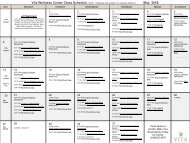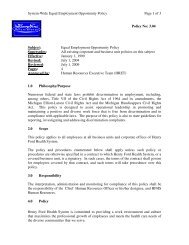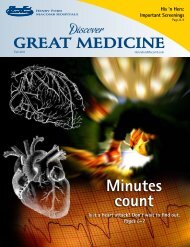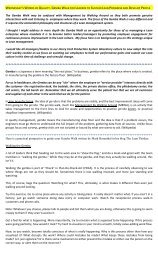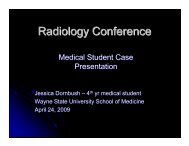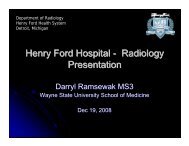New Drugs Antiplatelets-Antithrombotics - John Fanikos, RPh, MBA ...
New Drugs Antiplatelets-Antithrombotics - John Fanikos, RPh, MBA ...
New Drugs Antiplatelets-Antithrombotics - John Fanikos, RPh, MBA ...
- No tags were found...
Create successful ePaper yourself
Turn your PDF publications into a flip-book with our unique Google optimized e-Paper software.
Novel Anticoagulants andAntiplatelet Agents<strong>John</strong> <strong>Fanikos</strong>, R.Ph., M.B.A.Detroit, MIApril 21, 2010Disclosures• Speakers Bureau– None• Consultant– None• Board of Directors– North American Thrombosis Forum (NATF)• Family– Dad (James) CVS- Brother (Paul)BoehringerOutline• Potential pharmacologic targets• Limitations with current anticoagulantsand antiplatelet drugs• Agents moving through clinical trials– Early results– Ongoing Trials• Agents further upstreamObjectives• Cover the landscape of clinical trials• Recognize new agents underinvestigation• Describe clinical trials ongoing orrecently completed• Identify multicenter trials you or yourfacility may be able to join• Pinpoint a role for these new agents inyour daily clinical practiceTargets for Anticoagulation TherapyLimitations with Current Anticoagulation TherapyInitiationAmplification/PropagationHeparinsVitamin K antagonistsFactor Xa inhibitorsThrombinActivityIntrinsic system(surface contact)XIDirect thrombin inhibitorsXIIa(Prothrombin)XVa +IITF/VIIaVIIIaXaFibrinogenExtrinsic system(tissue damage)(Tissue factor)IXaIXFibrinVII Existing free and clotbound thrombincontinues to play arole in process ofhemostasis(Coagulation)Adapted from Kubitza D. Clin Pharmacol Ther 2005;78(4):412-421; Weitz J.I and Bates M. Journal of Thrombosis and Haemostasis. 2005;3:1843-1853XIaIIa(Thrombin)M0116AgentHeparinWarfarinLMWHIndirect XaInhibitor(e.g. fondaparinux)DirectThrombinInhibitorsDisadvantages• Parenteral administration• Risk of heparin-induced thrombocytopenia (HIT)• Narrow therapeutic window (low bioavailability, short halflife)• Requires frequent monitoring due to:– Narrow therapeutic window– Unpredictable pharmacology– Multiple drug–drug and food–drug interactions– Increased risk of major and minor bleeds• Parenteral administration• Risk of heparin-induced thrombocytopenia (HIT)• Parenteral administration• Long half-life• Limitations related to special patient populations• Parenteral administration• Current applications limited to cardiovascularmanagementAlbans S et al. Eur J Clin Invest 2005;35(Suppl 1):12-20.
Heparin RecallJan 17 th , 2008Feb 22 th ,2008Feb 24 th , 2008605040Heparin AftermathHeparin Reported Deaths n=398Deaths3020100Jan-07 May-07 Sep-07 Jan-08 May-08http://energycommerce.Chondroitin Dermatan Heparinhouse.gov20%17.3%Top 5 Medications causing EmergencyDepartment VisitsTargetParenteral agentOral agent15%13.0%Factor IIa (Thrombin)DesirudinXimelagatran10%80706050403020105%0%05.7%4.7%Budnitz DS et al. Ann Intern Med 2007:147:755-65http://www.stoptheclot.org/<strong>New</strong>s/article106.htm3.2%Warfarin Insulin ASA Clopidogrel Digoxin73%Emergency Room Events in WarfarinTreated Patients over 65 Years17%9%Bleed Elevated Lab OtherSkin GI Nose GU ICH Hemoptysis OtherFactor XaFactor VIIa/TF pathwayFactor IXaProtein C PathwayFactor Xa/Factor IIaBivalirudinArgatrobanIdraparinuxM118SSR126517DX-9056aOtamixibanTifacogin (TFPI)Factor VIIaiFactor IXa AptamerProtein CART123 (thrombomodulin)Hexadecasaccharide(SR123781A)Bemiparin (ultra LMWH)Hirsh J et al. Circulation 2007;116:552-660DabigatranOdiparcilRivaroxabanApixabanLY517717YM150Du-176b……TTP889…………
Targeting Blood Clotting Factors: IIa vs XaProcoagulant•Fibrin Formation•Platelet Activation•Feedback activation•TAFI ActivationInflammation•P-Selectinexpression•Cell adhesion•ChemotaxisThrombinAnticoagulant•Protein C, SActivation•ProstacyclinformationCell Proliferation•Tissue Repair•Growth Factorsecretion•AngiogenesisFactor XCell Proliferation &Inflammation•Cytokine release•Smooth muscle cellproliferationProcoagulant•Thrombin Formation•PAI-1 Release<strong>New</strong> Oral Anticoagulants vs WarfarinDrugDabigatranRivaroxabanApixibanWarfarinTargetFactor IIa(Thrombin)Factor XaFactor XaVitamin KepoxidereductaseDosingFixed,Once orTwicedailyFixed,Oncedaily, orTwiceDailyFixed,TwicedailyVariable,OncedailyCoagulationMonitoringNoNoNoYesHalfLife(h)14-179.09-14Eikelboom JW et al. Circulation 2007;116:131-13340RenalClearance(%)10065250InteractionsProton PumpInhibitorsPotentCYP3A4inhibitorsPotentCYP3A4inhibitorsMultipledrugs,dietaryVitamin KDabigatran Etexilate: An Oral DirectThrombin Inhibitor• Specific, competitive, reversible univalentthrombin inhibitor• Inhibits free and fibrin-bound thrombinactivity• Pro-Drug rapidly converted to active form• Rapid onset within 2 hours• Low bioavailability, 3.5-5%• Half life 12-17 hours• Renal clearance as glucuronic acidconjugate• Cytochrome P450 system isoenzymes arenot involved with metabolism, noinduction or inhibition.• Prolongs aPTT in a non-linear fashion• Approved in Europe and Canada Baetz BE. Pharmacotherapy 2008.Perzborn E. J Thromb Haemost 2005.Kubitza D., J Clin Pharmacol 2007.Rendix,Pradaxa ®Eikelboom JE. Thromb Haemostasis 2009.RE-COVER Trial DesignObjectiveconfirmationof VTE72 hE RE= enrollmentR= randomizationSingledummyperiodWarfarinplaceboWarfarinInitial parenteraltherapyUntil INR ≥2.0 attwo consecutivemeasurements(8-11 days)Double-dummy periodDabigatran etexilate 150 mg bidWarfarin placeboDabigatran etexilate placebo bidWarfarin(INR 2.0–3.0)6 monthsEnd of treatment30 daysfollow upSchulman S et al. N Engl J Med2009:361:2342-52Cumulative Risk of Recurrent VenousThromboembolism and Related DeathCumulative Risk of First Event of MajorBleeding and of Any BleedingEstimated Cumulative Risk (%)Estimated Cumulative Risk (%)DabigatranWarfarin, any bleedingDabigatran, any bleedingWarfarin, MBEDabigatran, MBEWarfarin and any bleedingWarfarinDabigatran andany bleedingNo. at riskMonths Since RandomizationDabigatran andmajor bleedingWarfarin andmajor bleedingDabigatran was non-inferior to warfarin for prevention of recurrent or fatal VTE(P
Most Common Adverse EventsDabigatran 150 mg bidOnly oraltreatmentn = 1226Overalln = 1273WarfarinOnly oraltreatmentn = 1214Overalln = 1266Headache (%) 60 (4.9) 79 (6.2) 64 (5.3) 88 (7.0)Pain in extremity(%)59 (4.8) 64 (5.0) 69 (5.7) 71 (5.6)Nausea (%) 43 (3.5) 49 (3.8) 43 (3.5) 58 (4.6)Diarrhea (%) 46 (3.8) 57 (4.5) 34 (2.8) 38 (3.0)Nasopharyngitis(%)47 (3.8) 50 (3.9) 53 (4.4) 54 (4.3)Dyspnea (%) 33 (2.7) 41 (3.2) 47 (3.9) 53 (4.2)Back pain (%) 42 (3.4) 46 (3.6) 44 (3.6) 50 (3.9)Arthralgia (%) 45 (3.7) 48 (3.8) 30 (2.5) 33 (2.6)Peripheraledema(%)41 (3.3) 43 (3.4) 45 (3.7) 48 (3.8)Dyspepsia (%) 36 (2.9) 39 (3.1) 7 (0.6) 9 (0.7)**p3 x ULN (%) 38 (3.1) 25 (2.1)AST >3 x ULN (%) 42 (3.4) 46 (3.8)ALT >3 x ULN +bilirubin >2 x ULN(%)2 (0.2) 4 (0.4)Schulman S et al. N Engl J Med 2009:361:2342-52RE-LY: A Non-Inferiority TrialPrimary Outcome: Superiority AnalysisP=.34P=.41Blinded Event Adjudication.OpenWarfarinadjusted(INR 2.0-3.0)N=6015Atrial fibrillation≥1 Risk FactorAbsence of contra-indications951 centers in 44 countriesRDabigatranEtexilate110 mg BIDN=6076BlindedDabigatranEtexilate150 mg BIDN=6022•Performed12/05-03/09•Median follow up2.0 years•Follow up 99.9%complete•Mean TTR = 64%(patients onwarfarin)Annual Rate3.0%2.5%2.0%1.5%1.0%0.5%0.0%P
Common Adverse EventsAdverse events occurring in>5% of any groupDabigatran110 mg%Dabigatran150 mg%Warfarin%Dyspepsia * 11.8 11.3 5.8Dyspnea 9.3 9.5 9.7Dizziness 8.1 8.3 9.4Peripheral edema 7.9 7.9 7.8Fatigue 6.6 6.6 6.2Cough 5.7 5.7 6.0Chest pain 5.2 6.2 5.9Arthralgia 4.5 5.5 5.7Back pain 5.3 5.2 5.6Nasopharyngitis 5.6 5.4 5.6Diarrhea 6.3 6.5 5.7Atrial fibrillation 5.5 5.9 5.8Urinary tract infection 4.5 4.8 5.6Upper respiratory tract infection 4.8 4.7 5.2*Occurred more commonly on dabigatran p3x ULNWarfarin Dabigatran110Dabigatran1500 0.5 1.0 1.5 2.0 2.5Years of Follow-upTargetPopulationStudy Design: Phase III TrialsRE-MOBILIZE RE-MODELTKR TKR THRRE-NOVATEDabigatran Dose 150 & 220 mg 150 & 220 mg 150 & 220 mg1 st DoseEnoxaparinDoseTreatmentDurationPrimaryEndpointNon-inferioritymargin6 to12 hourspost-op30 mg Twicedaily*1 to 4 hourspost-op1 to 4 hourspost -op40 mg Daily† 40 mg Daily†12 to15 days 6 to 10 days 28 to 35 daysTotal VTE + allcausemortalityTotal VTE + allcausemortality9.2 % 9.2% 7.7%Total VTE + allcausemortality*Commenced 12-24 h post surgery; †Commenced evening before surgery.Dabigatran vs Enoxaparin for Prevention ofVTE after Orthopedic Surgery• 3 trials vs Enoxaparin• Met non-inferioritymargins in 2 of 3• Overall rates of majorbleeding were low.40%30%20%10%0%P=.02, P
RE-VOLUTION - Trial ProgramPrimary VTE Prevention(completed)Acute VTETreatmentSecondary VTEPreventionSecondary Preventionin ACS—Phase IIStroke Prevention inAtrial FibrillationMore than 34,000 patients involvedRivaroxaban: An Oral Direct Factor XaInhibitorXarelto ®• Direct, specific, competitive FactorXa inhibitor• Inhibits free and fibrin-bound FactorXa activity and prothrombinaseactivity• Does not directly inhibit thrombin,but inhibits thrombin generation viadirect inhibition of Factor Xa activity• Rapid onset within 2-4 hours• High bioavailability of > 80%• No observed effects on agonistinducedplatelet aggregation• Does not require a cofactor such asantithrombin• No dosage adjustment for gender,age, extreme body weightPerzborn E. J Thromb Haemost 2005.• No interaction with aspirin,enoxaparin, digoxin,Kubitza D., J Clin Pharmacol 2007.naproxen, ranitidine, or antacidsEikelboom JE. Thromb Haemostasis 2009• Approved in Europe and CanadaGulseth GP. Am Soc Health-Syst Pharm 2008RECORD Phase III Trials: VTE ProphylaxisHIP replacementRivaroxaban 10 mg odfor 31–39 daysvsenoxaparin 40 mg odfor 5 weeksN=4,541HIP replacementRivaroxaban 10 mg odfor 31–39 daysvsenoxaparin 40 mg odfor 10–14 days thenoral placeboN=2,509 Same efficacy and safety outcomes Same independent, blinded committee adjudicated all outcomes 12,729 patients randomizedKNEE replacementRivaroxaban 10 mg odfor 10–14 daysvsenoxaparin 40 mg odfor 10–14 daysN=2,531KNEE replacementRivaroxaban 10 mg odfor 10–14 daysvsenoxaparin 30 mg bidfor 10–14 daysN=3,148IncidenceRECORD1RECORD2RRR 70%4%Prevention of VTE in THARRR 79% Extended prophylaxis with10%5 weeks of Rxrivaroxaban vs. short-termterm8%3%prophylaxis with enoxaparinRRR 88%6%RRR 88%2%4%RRR 80%1%2%0%0%Total VTE Major VTE Symptomatic Major BleedingTotal VTE Major VTE Symptomatic Major BleedingVTEVTEEriksson et al., N Engl J Med 2008Enoxaparin 40 mg QDKakkar et al., Lancet 2008;372:31–39RECORD3Rivaroxaban 10 mg QDRECORD4Prevention of VTE in TKAVTE Prevention TKARRR 49% 2 weeks of RxRRR 31%rivaroxaban daily vs20%11%enoxaparin bid for 2weeks15%8%6%10%4%RRR 62%5%RRR 65%2%0%0%Total VTE Major VTE Symptomatic Major BleedingTotal VTE Major VTE Symptomatic Major BleedingVTEVTELassen et al. N Engl J Med 2008Turpie AGG, et al. EFORT 2008. Abstract F85.EINSTEIN-EXTENSION STUDYRivaroxaban Clinical Development ProgramRivaroxaban 20mg Once DailyPlacebo(n = 594)P-Value(95% CI)(n= 602)Mean Duration 190 Days 190 Days NSRecurrent DVT, 8 (1.3%) 42 (7.1%) P11,000 patientsHip replacement or kneereplacementVs standard prophylaxis(enoxaparin)Vs standard prophylaxis(enoxaparin)~14,000 patientsNon-inferiority vs standardtherapy (warfarin)~7,500 patientsVs standard therapy~3,500 patientsNotesApproved inCanada; EUpending; FDAAdvisoryCommitteeMarch ‘09Late start201020102012Buller H. For the EINSTEIN Investigators Presented at American Society ofHematology Meeting, <strong>New</strong> Orleans Dec 2009.ATLAS ACS TIMI-51
Apixaban: An Oral Direct Factor Xa Inhibitor• Direct, reversible Factor Xa inhibitor• Rapid onset, peak within 3 hoursBMS-562247• Bioavailability of 51-85%• Small volume of distribution (16-25liters)• Long half life, slightly longer inelderly (15 hours)• Multiple elimination pathways– 25% renal– 75% biliary• Metabolism via CYP3A4, SULT1AApathways• Major metabolite phenol sulfateconjugateFrost C. J Thromb Haemost 2007.• Follow-up to Razaxaban (halted dueKubitza D., J Clin Pharmacol 2007.to high bleeding)Eikelboom JE. Thromb Haemostasis 2009ADVANCE-1 and ADVANCE-2 TrialsUni or Bilateral Total Knee Replacement Uni or Bilateral Total Hip ReplacementDouble-Blind, Double DummyDouble-Blind, Double Dummyp
Anti Xa Agents: ComparativePharmacokinetics & PharmacodynamicsDrugAbsorptionApixaban Rivaroxaban Edoxaban Betrixaban LY 517717 YM150(BMS) (Ortho) DU 176B (Portola/BMS) (Lilly) (Astellas)(Daiichi-Sankyo)• Reaches steady • Reaches • Reaches • Reaches steady • Reaches steady • Notstate within steady state steady state state within 72h state in 80 reported48hrwithin 24h within 24h • Peak to trough hours• Peak to trough • Peak to trough • Peak to ratio of 3.5:1 • 82% relativeratio of 5.5:1 Ratio 10:1 trough Ratio • 47% relative bioavailability• 66% relative • 80% relative 13:1bioavailabilitybioavailability. bioavailability. • 50% relative • Reduction in AUC• Delayed bioavailability and Cmax withabsorption .mealswith food• Half life of 8- • Half life of 9-Clearance & 15hr13hMetabolism • 25% renally • 66% renallycleared cleared.• Potent CYP3A4 • PotentPotential Drug inhibitors inhibitors of-DrugCYP3A4 andInteractionPGP• Half life of 9- • Half life of 19hr11hr• 5-10% renally• Mainly renally clearedcleared.• Potent • Low potentialCYP3A4inhibitors• Half life 25 hr • Not• Primarily reportedGastrointestinal• Not reported • NotreportedEriksson BI et al. Clin Pharmacokinet 2009;48(1):1-22Betrixaban Phase II Trial: EXPLORE-XaXaBetrixaban40 mg DailyNon Valvular Atrial Fibrillation561 Patients1:1:1:1Betrixaban60 mg DailyR3 months>1 Risk FactorsOver 75 years Prior CVACHFCADHypertension DiabetesBetrixaban80 mg DailyMajor, Clinically Relevant BleedingWarfarin INR2-31 Event 4 Events 5 Events 5 EventsEzekowitz MD et al. Present at the Amer Coll of Cardiology, Atlanta GA 2010YM150, as Prophylaxis for VTE in Patients withElective Primary Hip Replacement SurgeryMethods:• A randomized, enoxaparincontrolled,dose escalation study• Performed in 174 patientsundergoing elective primary hipreplacement surgery• Assessed the safety and efficacyof 7-10 days of treatment with oraldoses of YM150– (3, 10, 30, or 60 mg once dailystarting 6-10 h after surgery)– With s.c. enoxaparin (40 mg oncedaily starting 12 h before surgery)YM1503mg qdYM15010mg qdYM15030mg qdYM15060mg qdEnoxaparinMinorbleeds2.9%5.7%No trendNo trend22%Eriksson B.I., et al. Journal of Thrombosis & Haemostasis 2007; 5(8):1660-5.VTE52%39%23%19%39%Injectable Novel Agents: ComparativePharmacokinetics & PharmacodynamicsTargetDirectInhibitionRouteHalf-LifeRenalClearance• IIa• Yes• IV• 25 Min• 20%Routine • NoMonitoringAntidoteBivalirudin• No• IIa• Yes• SC• 6 hours• 100%• No• NoDesirudinBiotinylatedIdraparinux• Xa • Xa• No • Yes• SC• 17 hours• 100%• No• AvidinWeitz J et al. Lancet 2009;374:762-764Otamixaban• IV• 30 Min•
BOREALIS-AFBiotinylated IdraparinuxCASSEOPEIANon-Valvular AFPrior Stroke or TIA>2 Risk factorsSymptomaticPulmonaryEmbolism+/- DVTRRWarfarin INRadjustedOnce DailyBiotinylatedIdraparinux 3.0mgOnce WeeklyEnoxaparin 1 mg per kg dailyWarfarin INRadjustedOnce DailyBiotinylatedIdraparinux 3.0mgOnce Weekly1. All strokes or non CNSsystemic embolic events2. Major Bleeding or Death1. Recurrence of VTE at 3 and 6months2. Major BleedingPatients Reaching PrimaryEndpoint in 7 DaysDEATH OR MI in 7 Days65432108765432107.24.6SEPIA-ACS1 TIMI 42 Results3.8 3.60.035 0.07 0.105 0.14 0.175 UFH+Ept4.8Death, MI, UrgentRevascularization2.8Dose (mg/kg/hr)4.3RR vs 1.16 0.74 0.61 0.58 0.69ControlDeath or MI at 7 Days2.6 2.7 2.80.035 0.07 0.105 0.14 0.175 UFH+EptDose (mg/kg/hr)RR vs 0.98 0.57 0.52 0.56 0.58Control6.24.9Patients with ThromboticComplications During PCITIMI Major and MInorBleeding7654321065432106.2Thrombotic ComplicationsDuring PCI52.90.035 0.07 0.105 0.14 0.175 UFH+Ept1.6 1.63.5Dose (mg/kg/hr)3.10.035 0.07 0.105 0.14 0.175 UFH+Ept3.4Dose (mg/kg/hr)3.2RR vs 2.52 2.06 1.17 1.44 1.31ControlMajor or Minor BleedingRR vs 0.61 0.61 1.15 1.26 2.02ControlSabatine M. et al. Lancet 2009;374:787-7955.42.42.7REG1 Anticoagulation System• Comprisedof anaptamerbasedanticoagulant• RB006, &its matchedantidote,RB007REG1AnticoagulationSystem• Comprised of anaptamer-basedanticoagulant• Protein bindingoligonucleotide• Direct IXainhibitor•RB006, & itsmatched antidote,RB007Dyke CK. Circulation2006:114:2490-2497Baseline DataStudyDrugTimeline of ProceduresInformed consent will be executed prior to administration of any sedativesClopidogrel 600 mg loading dose and ASA 250-500 mg at least 4 hours prior to PCIPatients who receive heparin during diagnostic cath will wait at least 4 hours for the PCI procedureACTPTT (lab)Whole BloodPTT (POC)5 min 15 minPCIEndTnT, CKMB, CK q8h x 3Immediately Post4 hoursPCIRoll-In andRoll-In andGroup IGroup I:Complete ReversalPartial Reversaland Sheath PullororGroup II:HeparinComplete ReversalSheath PullandSheath Pull14 daysEnd of Follow-upIndefiniteASAClopidogrelrecommend12 months
Pharmacodynamic Properties of P2Y 12 InhibitorsPharmacodynamic Properties of P2Y 12 InhibitorsClopidogrelPrasugrelTicagrelor*Cangrelor*Elinogrel*ClopidogrelPrasugrelTicagrelor*Cangrelor*Elinogrel*RouteOralOralOralIVOral/IVRouteOralOralOralIVOral/IVReceptor BindingIrreversibleIrreversibleReversibleReversibleReversibleReceptor BindingIrreversibleIrreversibleReversibleReversibleReversiblePro-drugMetabolismYesCYP 3A4/52B6, 2C9,2C19YesCYP 3A4,2B6, 2C9,2C19*Investigational Agent, ** Active metabolite half-lifeMetabolicPathwaysNoCYP 3A4NoPlasmaesteraseNoNot ReportedPro-drugMetabolismClearanceEnteral BioavailabilityTime to peak plateletinhibitionPlasma half lifeDuration of antiplateleteffectDrug Interactions orgenetic polymorphismsYesCYP 3A4/52B6,2C9,2C19Renal 50%Fecal 46%50%300mg LD:6hrs600mg LD:2hrs8 hours**7 - 10 daysYesRenal 68%Fecal 27%1 - 2 hours8 hours**7 - 10 days*Investigational Agent, ** Active metabolite half-lifeYesCYP 3A4,2B6,2C9,2C1980%NoNoCYP 3A4Renal 1%NotReported2 hours6 - 12 hours1 dayNoNoPlasmaesterase-IV only30 mins3 - 9 mins20 - 60 minsNotReportedNoNot ReportedRenal 52%Fecal 48%Not Reported20 mins (IV)12 hours1 dayNot ReportedK Anger et al Irwin and Rippes Crit Care Med.8th EditionIndividual Response Variability to Dual AntiplateletTherapy in the Steady State Phase of TreatmentBalance ofEfficacy and SafetyNumber of Patients2015105Bleeding riskIschemic riskEndpoint (%)1510CV Death / MI / StrokeClopidogrel12.1Prasugrel9.9138eventsHR 0.81(0.73-0.90)P=0.0004NNT = 460Adapted from Angiolillo DJ et al. Am J Cardiol.2006;97:38-43.2.512.522.532.542.552.562.572.582.592.57.517.527.537.547.557.567.577.587.597.5% Platelet Aggregation (LTA-ADP ADP 20µmol/L)5TIMI MajorNonCABG BleedsPrasugrelClopidogrel00 30 60 90 180 270 360 450Days2.41.835eventsHR 1.32(1.03-1.68)P=0.03NNH = 167PLATO study designNSTE-ACS (moderate-to-high risk) STEMI (if primary PCI)Clopidogrel-treated or -naive;randomised within 24 hours of index event(N=18,624)ClopidogrelIf pre-treated, no additional loading dose;if naive, standard 300 mg loading dose,then 75 mg qd maintenance;(additional 300 mg allowed pre PCI)6–12-month exposurePrimary endpoint: CV death + MI + StrokePrimary safety endpoint: Total major bleedingPCI = percutaneous coronary intervention; ASA = acetylsalicylic acid;CV = cardiovascular; TIA = transient ischaemic attackTicagrelor180 mg loading dose, then90 mg bid maintenance;(additional 90 mg pre-PCI)Hierarchical testing major efficacy endpointsAll patients*Ticagrelor Clopidogrel(n=9,333) (n=9,291)HR for(95% CI) p value †Primary objective, n (%)CV death + MI + stroke 864 (9.8) 1,014 (11.7) 0.84 (0.77–0.92)
Total major bleedingK-M estimated rate (% per year)13121110987654321011.6NS11.2PLATO majorbleeding7.9NS7.7TIMI majorbleedingNS8.9 8.9Red celltransfusion *NS5.8 5.8PLATO lifethreatening/fatal bleedingTicagrelorClopidogrelNS0.3 0.3Fatal bleedingMajor bleeding and major or minor bleeding according to TIMI criteria refer to non-adjudicated events analysed with the useof a statistically programmed analysis in accordance with definition described in Wiviott SD et al. NEJM 2007;357:2001–15;* Proportion of patients (%); NS = not significantSubjectsSubjects who require PCI (with or without stent)1:1 randomization to main treatment groupsDouble blind, double dummyPlacebocapsules(to match)IndexProcedureEndpoints+Cangrelorbolus (30 µg/kg) &infusion (4 µg/kg/min)Clopidogrelcapsules(600 mg)Subjects who require PCIStudy drug infusion: for at least 2 hours or the durationof the procedure, whichever is longerClopidogrel capsules(600 mg)Placebo capsules(to match)Clopidogrel maintenance (at the discretion of the physician)+Placebobolus & infusion(to match)At 48 hours after randomization—• 1° efficacy endpoint: composite incidence of all-cause mortality, MI, and IDR• 2° efficacy endpoint: incidence of individual components, stroke & abrupt vessel closure• Safety endpoints: hemorrhage and transfusion• Safety: AEs/SAEsPrimary Endpoint:48-hour Death/MI/IDR (MITT)7.5%INNOVATE-PCI: Phase II TrialNon-Urgent PCI18-75 Years7.1%P = 0.59RRRClopidogrel 300or 600 mg Load,then 75 mg DailyElinogrel 80 mgIV then 50 mg,Oral Twice Daily60 DaysElinogrel 80 mgIV then 100 mg,Oral Twice DailyElinogrel 80 mgIV then 150 mg,Oral Twice DailyCangrelor: 3897 3623 3619 3619 3614 3606 3604 3603 3599Clopidogrel: 3871 3607 3606 3606 3602 3599 3598 3595 35881. Platelet activity2. Efficacy3.Safety4.TolerabilitySantilli F, Dabi G. Thromb Haemost 2009;101:220-221.
E5555: Phase II Trial: LANCELOTCoronary Artery Disease600 Patients1:1:1:1R40-80 yearsPost ACS DiabetesPost PCI + ↑hsCRPPAD, TIAStrokeE5555 50 mgDailyE5555 100mg DailyE5555 200mg DailyPlaceboevery day24 weeksSafety, Tolerability, Major Cardiovascular EventsSummary• Novel anticoagulants agents are under FDA review.• Novel antiplatelet agents are under investigation.• Each offers pharmacodynamic advantages overexisting agents.• Clinical trial results show comparable performance toLMWH and Warfarin.• Underlying disease still remains• More molecules are in early “discovery”.• The $ impact to patients, insurers, providers remainsa question.• Don’t “fall asleep at the whale”, follow trial resultsand identify your patients who may benefit from theseagents.







